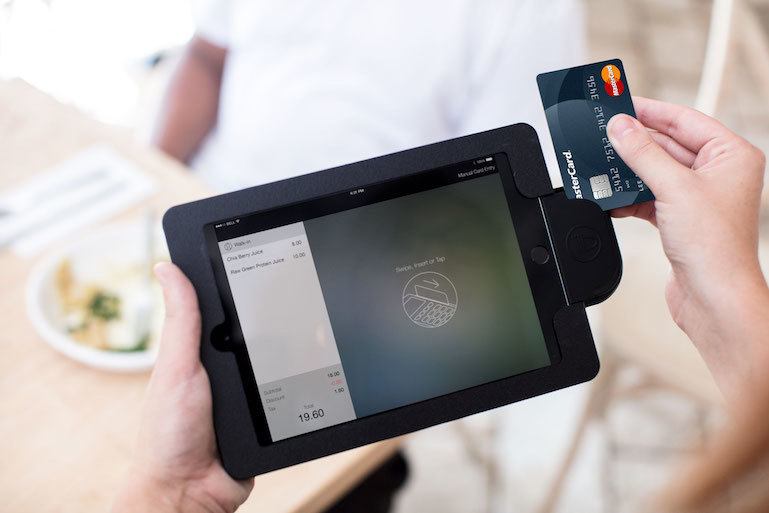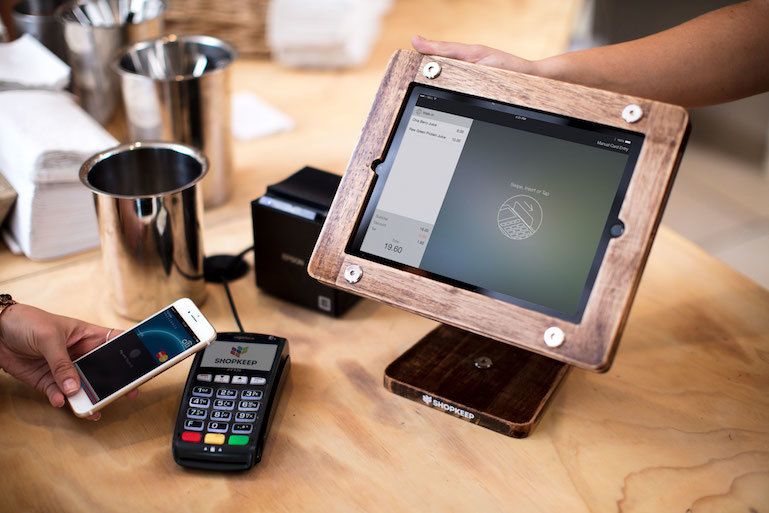
Small Business 101: What Are Restaurant Computer Systems?
In today’s fast-paced foodservice industry, restaurant computer systems are a vital tool for running an growing a restaurant business.
It’s fair to say that most restaurateurs get into the business out of a love of food and service, not technology. But like most industries, it’s impossible to escape the role that technology now plays in the foodservice industry. Fortunately, though, restaurant technology continues to evolve to the point that all but the most technology allergic restaurant managers can easily use a point of sale system without much training at all.
With that in mind, let’s take a closer look at restaurant computer systems to help you better understand how they work and how they can help your restaurant business be more successful. At the end of the article, you should be able to navigate the many options available to you to narrow it down to the right choice for your business.
What is a Restaurant POS System?
A restaurant computer system is really a POS system is a combination of a cash register, inventory management system, reporting & analytics tool, and employee management platform. Combining all of those features into one tool simplifies the technology needs for business owners while delivering an interconnected system that gives a restaurant a more significant shot at long-term success.
Cloud-Based Software versus On-Premise Software
With a basic understanding of restaurant POS systems at your disposal, the first wrinkle you’ll encounter is whether a system is cloud-based or on-premise. These two terms refer to the underlying way that the software is architected and built. That might seem complicated, but don’t worry, it’s pretty simple. And understanding the difference doesn’t require a computer science degree.
On-premise software gets its name because it’s installed on a server that’s physically housed within your place of business. It’s literally on the premises of where it’ll be used. For years, this was the only way that software was distributed to both businesses and consumers. If you’re old enough, you may remember going to an electronics store and buying a copy of Microsoft Office, leaving with a box, and installing it on your PC with a CD-ROM or a set of floppy disks. The same general principle holds true for on-premise POS software.
Today, this approach seems totally archaic. Software is more commonly paid for via a monthly subscription fee, and it’s rarely installed within the physical confines of a business. Instead, it’s running on a server in a data center that’s operated by the vendor or leased from a third-party like Amazon Web Services (AWS). These data centers are referred to as “the cloud.”
To access the software, you log into it from any web browser. In the case of a POS system, you will likely need to install a companion application on whatever device (iOS and Android tablets) that you use as your register. This approach saves you from the hassle of installing software on your devices, dealing with complex update processes, or needing to be in your business to access your POS system.
It’s important to note some other benefits of cloud-based software that are particularly beneficial to independent restaurant owners:
Free Updates
With your monthly subscription fee, you typically get free software updates for as long as you’re a customer. With on-premise software, you need to pay for each new software version.
Managed Security
POS systems deal with sensitive customer data. With the cloud, data security is managed by the software vendor, making your life much easier. With on-premise software, this is typically your responsibility.
Greater Ease of Use
Cloud-based software and mobile POS systems generally feature more modern designs that are easier for staff (and you) to use. On-premise software is typically older with outdated and overly complicated user interfaces.
More Affordable
On-premise software typically requires an upfront purchase that can cost several thousand dollars per terminal when you factor in the price of software and hardware. On the other hand, cloud-based software is paid for via an affordable monthly fee and runs on commodity hardware like iPads and Android tablets.
We’re just going to go out on a limb and say it. For an independent restaurant owner, there’s no reason to consider on-premise software. You’ll get more features for a smaller financing investment with fewer headaches and hassles if you go with cloud-based restaurant point of sale software.
With that in mind, let’s look into the specific functionality that you should look for when evaluating restaurant POS systems against one another.
Transactions and Order Entry
Transactions and order entry refers to the parts of your POS system that are used to take orders from patrons and process transactions. With that in mind, you’ll want to think about how these features impact your waitstaff and kitchen staff.
Most restaurants will want to focus on ease of use above almost everything else. The hectic pace of the hospitality industry and quick-service restaurants in particular), the relative inexperience of staff, and the “custom” nature of orders drive this requirement. In a business where many things can go wrong, turning a loyal customer into someone you’ll never see again, it’s best to play it safe and eliminate as much risk as possible.
With that in mind here are some of the major POS features you’ll want to ensure your next system has:
Easy to Use Interface
Fortunately, most cloud-based POS systems include this feature out of the box by virtue of being more up to date with current software design trends. In general, you’re looking for an interface that features colorful buttons with easy to read labels or the ability to use images of menu items (burger and fries) as the button. Almost all restaurant POS systems use a touch screen, so you’ll want the buttons to be large and easy for servers to tap.
Customizable Orders
Almost no order in the restaurant world is standard. Even if you put “no substitutions” on the menu, customers are still going to ask. That’s why it’s important that it’s easy for waitstaff to make these order customizations. If you sell dishes that are custom by their nature (think build-your-own burgers), then you’ll want the ability to use “modifiers” to construct each customer’s order.
Tableside Ordering
This operational approach uses the mobile nature of tablet POS solutions to let staff use a tablet to take orders right from a guest’s table. This reduces the time required for order entry and sending orders to the kitchen for preparation, getting food into your customers’ hands sooner.
This higher level of service should boost customer satisfaction, increase tips for waitstaff, and improve the overall efficiency of your restaurant.
Check Management
Any experienced restaurant server likely has a few dozen horror stories related to splitting checks. Good news. With the right restaurant point of sale system, those stories are a thing of the past. Your staff will be able to split checks with a few taps, transfer checks between terminals and servers, and quickly ring up transactions.
Table Layout
A must-have for restaurants, table layout allows you to recreate your floor plan on your POS terminal screen. From there you can assign servers to specific tables, servers can easily update orders and print checks by tapping on a table, and more. In general, this visual representation of your business helps your staff stay organized and efficient, particularly important during a busy Friday dinner rush.
Kitchen and Bar Printers
Modern POS systems also support multiple order printers and kitchen displays. When you waitstaff enters an order into a POS terminal, it’s automatically sent to the kitchen and/or bar.
Since your staff doesn’t need to run the order to these departments, food and drinks are prepared faster. Since the order is printed from the POS or displayed on a screen, there’s also no messy handwriting to decipher, leading to greater accuracy.
Online Ordering
If you want to offer delivery or pickup services, then online ordering is almost a necessity. Tools that enable this functionality come in all shapes and sizes. Some POS systems include them built-in while other restaurants choose third-party services that must be integrated into their POS systems.
The choice is up to you, but you’ll want to choose a solution that works alongside your POS system to simplify billing. It’s also ideal if you can have an order sent directly to your kitchen printer to help minimize wait times (speed is the name of the delivery game). Lastly, if your solution can send SMS or email notifications to the customer altering them that their food is ready or your driver is on the way, all the better.
SEE ALSO: 13 Simple Ways to Reduce Waiting Time in Restaurants
Inventory Management for Restaurants
In an industry where inventory has a limited shelf life, it’s particularly important to have powerful inventory management tools at your disposal. Otherwise, you run the risk of losing significant capital through spoiled food and poor portion control. You even run the risk of getting customers sick with issues like food poisoning if you don’t stay on top of your inventory.
Pairing the right inventory management process with the right tools can help you prevent the issues. It’s outside the scope of this article to go into inventory management processes in great detail, but we can share some of the tools you should look out for.
Managing with Ingredients and Raw Goods
Foodservice differs from retail in that products (dishes) are comprised of many smaller components. To help manage inventory in this way, many systems offer a feature that lets you manage inventory at the ingredient or component called level. An example is if you sell coffee drinks (drip, espresso, etc.), you can manage inventory starting with coffee beans or pre-ground coffee. This allows you to maintain strict portion control and track how much of a raw ingredient you’re using.
It’s important to note that raw goods aren’t always 100% accurate, and they aren’t necessarily the best fit for every type of restaurant. However, many restaurants and cafes do use them as a practical component of their overall inventory management process.
Reorder Triggers
With inventory continually going bad or expiring, you need a simple way to track when you need to reorder more stock, and how much each order should include. Reorder triggers are the answer. This tool allows you to set reminders for order times and quantities, so you never lose track or run the risk of not having the ingredients needed to make a popular dish in stock.
Reporting and Analytics
This powerful feature is one of the top reasons to use a POS system. It’s almost impossible to put a price on the value that comes from having deep insight into all areas of your business. From inventory value to sales performance to labor cost and more, reporting and analytics are the keys to successful and effective restaurant management.
Sales Reports
As their name implies, sales reports help you understand your sales performance at both an overall and item level. Some insights you can glean from sales reports include:
- Which shift – breakfast, lunch, dinner – is driving the most revenue?
- Which dishes and drinks are selling the most and least?
- Which day is lagging in sales volume?
With these insights in hand, you’re able to make more informed decisions about inventory, marketing, staffing levels, and more.
Inventory Reports
As we covered above when discussing inventory management tools, understanding the finer details of your inventory is key to maximizing your investment in it. While inventory management tools help with that, inventory reports are another equally important tool. Here are some of the insights that you can expect to glean from inventory reports:
- Profit Margins – understand which dishes are most profitable for your restaurant.
- Inventory Value – track the amount of capital that you have tied up in your inventory to manage cash flow better.
- Stock Levels – While you might have reorder triggers set up, inventory reporting will allow you to quickly see your quantity on hand when you need that info.
Employee Reports
Great employees are one of the keys to running a successful restaurant. And while a POS system can’t motivate your team or give them customer service tips, it can give you insights into their performance to help you optimize your approach to staffing.
- Sales Performance – Particularly relevant for bartenders and waitstaff, you can see how much revenue each employee is bringing in for your business.
- Hours Worked – Whether you’re trying to create next week’s schedule or run payroll, quickly and accurately tracking the hours your employees’ work is a huge timesaver.
- Labor Cost – With this report you can clearly see how much you’re spending on labor versus the amount of revenue you’re generating to determine whether to staff up or down in future shifts.
Marketing Tools
To grow, you need to market your business. And while a point of sale system will likely never replace a purpose-built marketing platform, many do include basic marketing features that can be leveraged for growth.
Customer Relationship Management (CRM)
One of the foundational principles of modern marketing is that it’s all about building and maintaining relationships. CRM tools are one of the best ways to facilitate this process.
CRM tools allow you to create a record in your POS system for each customer that buys from you. This record can include basic information like name and contact details, as well as more specific info like purchase history.
Your waitstaff can use this data to guide conversations with guests to recommend dishes and generally provide a more personalized level of service. You may also be able to pass this data into other marketing platforms to tailor email and marketing communications to the specific needs of your customer.
Email Marketing
While it may be ancient in the world of digital marketing, email is still one of the most effective (and affordable) marketing channels. But how do point of sale systems fit into the picture? Most POS systems allow you to collect customer email addresses. If your POS system integrates with a third-party email marketing tool like MailChimp or Constant Contact, you can then automatically send those collected addresses to that tool. This significantly streamlines your entire email marketing operation.
Loyalty Programs
Since restaurants thrive off of repeat business, a customer loyalty program is a must-have. While the details of these programs can differ between businesses, the basic structure is the same. After making enough purchases, a customer is rewarded with a discount on a subsequent purchase.
The key for you is to find a platform that gives you flexibility around setting up the specifics of your program. You’ll also want something that’s built into your POS system or integrates with it. That way when a customer makes a purchase, your loyalty program will automatically update based on activity.

Payment Processing and POS Hardware
To complete your restaurant POS system, you’ll need the right POS hardware. For a restaurant, the main focus of this hardware is to facilitate payment processing. To that end, here are the major hardware components you’ll want to add to your setup:
- Cash Drawer – As its name implies, a cash drawer connects to your terminal and holds your cash along with any important documents you want to keep at the ready.
- Credit Card Reader – Ensure that your reader can accept credit cards, debit, contactless payment, EMV transactions and any other payment method your customers prefer using.
- Receipt Printer – Lastly, you’ll want a receipt printer when it comes time to distribute checks to guests. Unlike your kitchen printer, most receipt printers use thermal paper to print.
Customer Support
While not strictly a feature of a POS system, customer service should be an essential part of your vendor evaluation process. One of the harsh realities of the foodservice world is that you often work outside of regular l business hours. That means you need customer support that works outside of normal hours too. After all, if your card reader stops working or your terminal goes on the fritz, that can cost you a significant amount of revenue.
In an ideal world, you want to work with a vendor that offers customer support 24/7/265. That support should also be available through a variety of communication channels, giving you the flexibility to communicate in the way that’s best for you. A robust knowledge base of video and written tutorials rounds out the package by giving you the resources you need to troubleshoot and problem solve on your own should you choose to do so.
While restaurant computer systems and POS systems might seem complicated at first glance, we hope this article has helped to clear up any of your confusion. Choosing the right one is really about narrowing down your choices to the few that meet your needs and align with your budget. From there, it’s just a matter of working the tools into your day to day business operations.
Want to try ShopKeep for yourself?
Just answer a few easy questions.
Need help finding the right point of sale?
Just complete the form. We’ll call you right back to explain how ShopKeep can work for you.
Hit the ground running.Sprinting, in fact!
Read our free, comprehensive guide, Small Business 101, to learn all you need to know about starting a thriving business.

